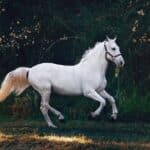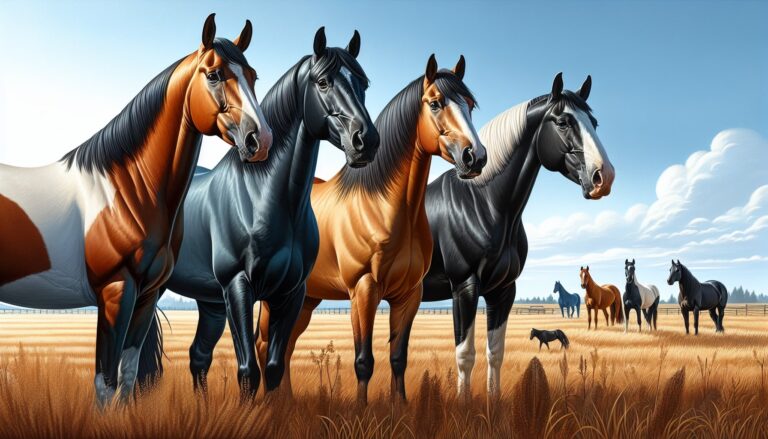
Ever found yourself pondering, ‘How do horses mate?’ If so, you’re not alone. The world of horse mating is a captivating blend of instinct, ritual, and biology that can seem almost mystical to the uninitiated. From the primal dance of courtship to the scientific precision of artificial breeding, this comprehensive guide uncovers the secrets behind how horses mate.
Whether you’re an equine enthusiast, a curious observer, or someone deeply involved in horse breeding, prepare to embark on an enlightening journey into the complex and fascinating life of these majestic creatures.
- The Triple-Phase Process: Horse Mating Behavior
- The Domesticated Twist: Mating Among Domestic Horses
- Wild Horse Breeding Behavior: Nature’s Intricate Dance
- How Do We Know if the Mating Was Successful?
- When are Horses Ready to Mate?
- Understanding Horse Breeding Season
- Final Thoughts On How Horses Mate
The Triple-Phase Process: Horse Mating Behavior
Both wild horses and domesticated horses follow a three-stage process when it comes to mating. This includes courtship, copulation, and post-mating activities.
Stage 1: The Dance of Courtship
The initial stage of courtship in horses can often be intense, marked by high levels of aggression from both the stallion and the mare. The stallion, driven by his instinctual desire to breed, monitors the mare for signs that she is in heat.
During this phase, the stallion engages in a display of dominance, prancing around the mare with ears perked and neck arched. He even vocalizes his interest through nickering or whinnying. The stallion’s approach to the mare involves sniffing from the front, focusing on her face, neck, withers, and front legs.
Unreceptive Mares: Saying No to Mating
Mares that are not ready to mate can exhibit aggressive behavior towards the interested stallion. These signs include:
- Flattening her ears
- Biting or kicking at the stallion
- Attempting to run away
- Clamping the tail over the perineum to prevent access to the vagina
On the other hand, aggressive stallions have been observed to pursue their interest, often leading to forced matings.
Receptive Mares: Saying Yes to Mating
When a mare is ready to mate, her behavior becomes more submissive. She presents her hindquarters to the stallion, moves her tail aside, squats, and rhythmically everts her vagina – a phenomenon commonly referred to as “winking”. The mare also actively seeks the stallion’s attention, engaging in mutual grooming and other bonding behaviors.
Stage 2: Copulation – The Act of Mating
The second phase of horse mating behavior involves the act of copulation itself. The stallion mounts the mare either from behind or laterally. The mounting process involves the stallion gripping the mare with his forelegs while bringing his head close to her neck. In some instances, stallions may attempt to stabilize themselves by biting the mare’s neck and mane.
The act of copulation involves strong intravaginal thrusting by the stallion, culminating in ejaculation. This phase is often accompanied by grunts and squeals from both the mare and stallion.
Stage 3: Post-Mating Rituals
Post-mating behavior in horses involves a series of activities, primarily related to hygiene and preparation for potential subsequent mating attempts. The stallion dismounts and retracts his penis into his sheath. Stallions with high libido may cover a receptive mare multiple times in a day.

The Domesticated Twist: Mating Among Domestic Horses
In domestic scenarios, horse mating can occur under three conditions:
- Natural pasture mating
- Natural in-hand mating
- Artificial breeding with fresh, chilled, or frozen semen
Natural Pasture Mating
This method is similar to wild horse mating, where the stallion and mare mate without human interference. The stallion and mare are left to their own devices in a pasture setting, mimicking the natural mating behaviors observed in wild horses.
Advantages:
- Low Stress: The horses are allowed to interact freely, reducing stress levels.
- Reduced Handler Risk: With no human intervention during the mating process, the risk of handler injury is minimized.
Disadvantages:
- Unpredictable Timing: It’s challenging to determine the exact conception date, making it difficult to predict the foal’s birth date.
- Disease Risk: The lack of controlled conditions increases the potential for the transmission of sexually transmitted diseases.
Natural In-Hand Mating
Here, handlers guide the stallion and mare during the mating process, ensuring that copulation occurs under controlled conditions.
Advantages:
- Controlled Timing: Knowing the exact date of conception aids in planning and prenatal care.
- Reduced Injury Risk: Handlers can intervene to prevent potential injuries to the horses.
Disadvantages:
- Increased Stress: The presence of handlers and a controlled environment can stress the horses.
- Handler Risk: Despite precautions, there’s always a risk of injury to the handlers.
Artificial Breeding
Artificial breeding involves collecting the stallion’s semen and later inseminating the mare. This is most commonly found on breeding farms.
Advantages:
- Safety: No physical contact between the mare and stallion minimizes injury risk.
- Disease Control: Semen can be screened for diseases before insemination.
- Flexibility: Semen can be stored and even transported, offering a wide range of breeding possibilities.
Disadvantages:
- Cost: The need for specialized equipment and professionals can make this method expensive.
- Lower Conception Rates: Artificial insemination may result in lower conception rates compared to natural methods.

Wild Horse Breeding Behavior: Nature’s Intricate Dance
In the untamed expanses where wild horses roam, breeding is a complex, instinct-driven process that has evolved over thousands of years. Unlike their domesticated counterparts, wild horses follow a set of behaviors deeply rooted in survival and natural selection.
The Role of the Stallion
In wild horse herds, the dominant stallion is generally the primary breeder. He earns this role through displays of strength and dominance, often having to fight off rival stallions. His primary job is to protect the mares in his herd and sire the next generation.
Courtship in the Wild
Courtship rituals in the wild are intense and can involve aggressive behaviors from both the stallion and the mare. The stallion will sniff and nuzzle the mare to determine if she is in estrus, often accompanied by vocalizations like nickering and whinnying.
Mating and Hierarchy
Mating usually occurs according to a hierarchy within the herd, with the dominant mare typically being the first to mate with the stallion. Subordinate mares will follow, and the stallion may cover multiple mares in a short period, especially if they are all in the estrus cycle.
Post-Mating Dynamics
After mating, the stallion continues to play a protective role, guarding the mares from potential threats. This ensures the safety of the pregnant mares and, eventually, the foals that are born.
Natural Selection at Play
In the wild, only the fittest survive, and this principle extends to breeding. Traits that enhance survival are passed down through generations, contributing to the robust and resilient nature of wild horse populations.

How Do We Know if the Mating Was Successful?
Determining if a mare is pregnant can be done through observation, blood tests, rectal palpation, and ultrasonography.
Observation
Observation involves monitoring the mare for signs of a season 18 to 23 days after mating. If no signs are noticed, it’s likely that the mare is pregnant.
Blood Tests
Blood tests can be used to measure the mare’s hormone levels, which can indicate pregnancy.
Rectal Palpation
In the absence of an ultrasound, veterinarians can use rectal palpation to determine if the mare is pregnant. This involves feeling for the developing embryo through the rectal and uterine walls.
Ultrasonography
Ultrasonography is the most reliable method for determining pregnancy in mares. It allows for the detection of twins and provides a precise timeline of the pregnancy.
When are Horses Ready to Mate?
Mares and stallions can only mate once they reach sexual maturity. This typically occurs between 15 to 18 months for mares and between 12 to 14 months for stallions. However, it’s recommended that breeding is delayed until the horses have finished growing to ensure peak health and fertility.
Understanding Horse Breeding Season
When it comes to horse breeding, timing is everything. Unlike some animals that can breed year-round, horses have a specific breeding season that aligns with the natural rhythms of their environment.
The Seasonal Cycle
In regions of the Northern Hemisphere—which includes parts of North America, Europe, and Asia—the horse breeding season typically begins in late spring and extends through early fall, peaking between May and July. Horses are seasonal breeders primarily because their 11-month gestation period aligns well with the warm climate of spring and summer, offering optimal conditions for raising foals. This timing is designed to ensure that foals are born during the milder weather conditions of late winter or early spring, thereby increasing their chances of survival.
Photoperiod Influence
One fascinating aspect of horse breeding is the role of daylight, or photoperiod, in triggering reproductive behaviors. As the days lengthen, the increased exposure to light stimulates the production of hormones that prepare both mares and mature stallions for breeding.
Controlled Environments
In managed breeding programs, artificial lighting can be used to manipulate the breeding season, allowing for more flexible scheduling. However, this method should be used cautiously, as it can disrupt the natural hormonal balance of the horses.
Seasonal Challenges
While the breeding season offers a window of opportunity, it also presents challenges such as increased competition among stallions and heightened stress levels in mares. Understanding these seasonal dynamics can help breeders make informed decisions.
Final Thoughts On How Horses Mate
Understanding how horses mate provides valuable insights into their behavior and biology. Whether you’re a horse owner, an equine enthusiast, or just curious about the topic, this guide sheds light on the fascinating world of horse mating.











